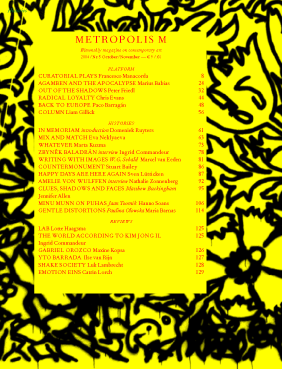Countermonument
In 1957 the British sculptor Henry Moore, ambassador of soft Western modernism, was appointed chairman of the jury of the International Auschwitz-Birkenau Memorial Competition, which invited open proposals for a public monument to commemorate the tragedies of the former concentration camp. The entrants were bound by a single constraint: the work would be located on the original Auschwitz site, whose basic form and foundations should be preserved. Seven out of 400 proposals were shortlisted from an international range of architects and artists, the most subversive of which was devised by a team led by Polish architect Oskar Hansen. Hansen’s idea was simple: lay a 70m wide, 1,000m long blach tarmac road diagonally across the former site, literally crossing over – and crossing out – the horror of the past. Everything else would remain intact. Visitors would enter from the back of the site (negating the original function of the camp), cut across Birkenau’s main gate through which the trains transported victims (so no-one would ever access the camp in the same way again), and exit abruptly into the abundant nature of the surrounding forrest (into peace and ongoing life). Hansen described the form as ‘an expression of silence, and and a site for spontaneous gestures: if one should wish to leave a note with a name, or a figure of an angel, one could do it by the road’.These ideas were true to his wider notions of Open Forms, a human-sized set of principles for shaping social space which he was busy exploring through other architecture and art projects. Curiously, the jury never actually nominated an outright winner. Apparently they voted unanimously for Hansen’s proposal, but the project was forced into comprise following protest from the Auschwitz survivors that they were unable to identify their suffering with such an abstrat expression of rememberance. Henry Moore released a much-publicized statement in which he questioned whether a work of art can express the emotions engendered by Auschwitz, an that a very great sculptor – a new Michaelangelo or a new Rodin – might have achieved this. The odds against such a design are turning up among the many maquettes submitted were always enormous. And none did. A compromised amalgamation pf several ideas were developed including sculptures of railway carriages in relation to the road, which softened Hansen’s abstraction and closed the Open Form. Hansen withdrew any further involvement, announcing it contaminated the principles of his so-called antimonument manifesto. As his akward statement suggests, Moore’s position in the Auschwitz competition was always uncomfortable, and he too resigned during the final stages. The exact reasons why are unclear, though it is suggested that his name was being used for extra-artistic, political reasons. At the time of Hansen’s rejection, in 1958, Moore had just completed his much-celebrated Reclining Figure for UNESCO in Paris, and a year later his work was shown in Poland for the first time. This was the acceptable face of soft modernism about to be imported to the East, but in between lingering chlichés of Eastern and Western European art, the story of Hansen’s curiously overlooked moment of hard modernism transcends both. This text is based on the larger article ‘Oskar Hansen and the Auschwitz “Countermemorial,”‘ 1958-59 by Katarzyna Murwaska-Muthesius.
Stuart Bailey



















